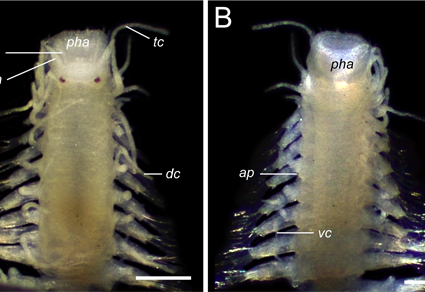Abstract
We describe M. fujianensis n. sp. (Annelida: Hesionidae), collected from the coast of Fujian Province, China, based on morphological and molecular analyses. Micropodarke fujianensis n. sp. is characterized by having two pairs of minute eyes, and neurochaetae of middle segments without basal long teeth. The K2P distances of COI, 16S rRNA, 18S rRNA, 28S rRNA, and histone H3 fragments diverged from the corresponding sequences of the closest related species of Micropodarke in GenBank and BOLD Systems by 22.3%, 10.7%, 0, 1.15%, and 1.1%, respectively. Among the Micropodarke species with such DNA sequences for comparison, M. fujianensis n. sp. is most closely related to M. cf. dubia—a species collected from Daya Bay, China. An updated key to Micropodarke species is provided.
References
Carr, C.M., Hardy, S.M., Brown, T.M., Macdonald, T.A. & Hebert, P.D. (2011) A tri-oceanic perspective: DNA barcoding reveals geographic structure and cryptic diversity in Canadian polychaetes. PLOS One, 6 (7), e22232. https://doi.org/10.1371/journal.pone.0022232
Colgan, D.J., McLauchlan, A., Wilson, G.D.F., Livingston, S.P., Edgecombe, G.D. Macaranas, J., Cassis, G. & Gray, M.R. (1998) Histone H3 and U2 snRNA DNA sequences and arthropod molecular evolution. Australian Journal of Zoology, 46 (5), 419–437. https://doi.org/10.1071/ZO98048
Giribet, G., Carranza, S., Baguñà, J., Riutort, M. & Ribera, C. (1996) First molecular evidence for the existence of a Tardigrada + Arthropoda clade. Molecular Biology and Evolution, 13 (1), 76–84. https://doi.org/10.1093/oxfordjournals.molbev.a025573
Hessle, C. (1925) Einiges über die Hesioniden und die Stellung der Gattung Ancistrosyllis. Arkiv för Zoologi, 17a (10), 1–36.
Kimura, M. (1980) A simple method for estimating evolutionary rates of base substitutions through comparative studies of nucleotide sequences. Journal of Molecular Evolution, 16 (2), 111–120. https://doi.org/10.1007/BF01731581
Kumar, S., Stecher, G., Li, M., Knyaz, C. & Tamura, K. (2018) MEGA X: Molecular Evolutionary Genetics Analysis across computing platforms. Molecular Biology and Evolution, 35, 1547–1549. https://doi.org/10.1093/molbev/msy096
Lenaers, G., Maroteaux, L., Michot, B. & Herzog, M. (1989) Dinoflagellates in evolution. A molecular phylogenetic analysis of large subunit ribosomal RNA. Journal of Molecular Evolution, 29 (1), 40–51. https://doi.org/org/10.1007/BF02106180
Nguyen, L.T., Schmidt, H.A., von Haeseler, A. & Minh, B.Q. (2015) IQ-TREE: A fast and effectivestochastic algorithm for estimating maximum-likelihood phylogenies. Molecular Biology and Evolution, 32 (1), 268–274. https://doi.org/10.1093/molbev/msu300
Palumbi, S.R., Martin, A., Romano, S., McMillan, W.O., Stice, L. & Grabowski, G. (1991) The Simple Fool’s Guide to PCR. Version 2.0. University of Hawaii, Honolulu, 45 pp.
Pleijel, F. & Rouse, G. (2005) A revision of Micropodarke (Psamathini, Hesionidae, Polychaeta). Journal of Natural History, 39 (17), 1313–1326. https://doi.org/10.1080/00222930400020129
Rizzo, A.E. & Salazar-Vallejo, S.I. (2014) Hesionidae Grube, 1850 (Annelida: Polychaeta) from South-Southeastern Brazil, with descriptions of four new species. Zootaxa, 3856 (2), 267–291. https://doi.org/10.11646/zootaxa.3856.2.7
Rouse, G.W., Carvajal, J.I. & Pleijel, F. (2018) Phylogeny of Hesionidae (Aciculata, Annelida), with four new species from deep-sea eastern Pacific methane seeps, and resolution of the affinity of Hesiolyra. Invertebrate Systematics, 32 (5), 1050–1068. https://doi.org/10.1071/IS17092
Silvestro, D. & Michalak, I. (2012) raxmlGUI: a graphical front-end for RAxML. Organisms Diversity & Evolution, 12, 335–337. https://doi.org/10.1007/s13127-011-0056-0
Uchida, H. (2004) Hesionidae (Annelida, Polichaeta [sic]) from Japan. I. Kuroshio Biosphere, 1, 27–92.
Van der Auwera, G., Chapelle, S. & De Wächter, R. (1994) Structure of the large ribosomal subunit RNA of Phytophthora megasperma, and phylogeny of the oomycetes. FEBS Letters, 338 (2), 133–136. https://doi.org/10.1016/0014-5793(94)80350-1
Wang, Z., Qiu, J.-W. & Salazar-Vallejo, S.I. (2018) Redescription of Leocrates chinensis Kinberg, 1866 (Annelida, Hesionidae). Zoological Studies, 57, 5. https://doi.org/10.6620/ZS.2018.57-05
Wang, Z., Xu, T., Zhang, Y.J., Zhou, Y.D., Liu, Z.S., Chen, C., Watanabe, H.K. & Qiu, J.-W. (2020) Molecular phylogenetic and morphological analyses of the ‘monospecific’ Hesiolyra (Annelida: Hesionidae) reveal two new species. Deep Sea Research Part I: Oceanographic Research Papers, 166, 103401. https://doi.org/10.1016/j.dsr.2020.103401
WoRMS Editorial Board (2022) World Register of Marine Species. VLIZ. Available from https://www.marinespecies.org (accessed 9 December 2022) https://doi.org/10.14284/170
Zhang, D., Gao, F., Jakovlić, I., Zou, H., Zhang, J., Li, W.X. & Wang, G.T. (2020) PhyloSuite: an integrated and scalable desktop platform for streamlined molecular sequence data management and evolutionary phylogenetics studies. Molecular Ecology Resources, 20, 348–355. https://doi.org/10.1111/1755-0998.13096


